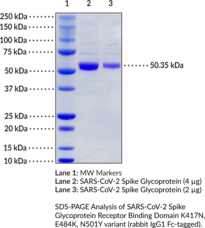Territorial Availability: Available through Bertin Technologies only in France
- Correlated keywords
- SARSCoV-2 SARS-CoV2 SARSCoV2 COVID19 K 417N K417 N E484K E 484K E484 K N501Y N 501Y N501 Y
- Product Overview:
Severe acute respiratory syndrome coronavirus 2 (SARS-CoV-2) is an enveloped positive-stranded RNA virus, a member of the Betacoronavirus genus, and the causative agent of COVID-19.{53462,53459,53461,55257,55258} The SARS-CoV-2 spike glycoprotein, also known as the surface glycoprotein, is located on the outer envelope of the virion.{53462} It is composed of an S1 and S2 subunit divided by a furin S-cleavage site not found in other SARS-CoVs.{46767,49561} The S1 subunit contains the receptor-binding domain (RBD), which binds to the carboxypeptidase angiotensin-converting enzyme 2 (ACE2), and the S1 and S2 subunits are cleaved by the protease TMPRSS2 to facilitate viral fusion with the host cell membrane.{49542,49536,49558} In this way, ACE2 acts as the functional receptor for SARS-CoV-2. The SARS-CoV-2 variant of concern (VOC) B.1.351, originally identified in South Africa, contains three substitutions located within the spike glycoprotein RBD.{60562,61502} The lysine-to-asparagine substitution at position 417 (K417N) reduces SARS-CoV-2 affinity for human ACE2, whereas the glutamate-to-lysine substitution at position 484 (E484K) and the asparagine-to-tyrosine substitution at position 501 (N501Y) increase SARS-CoV-2 affinity for human ACE2.{60562} Collectively, the K417N, E484K, and N501Y substitutions are associated with enhanced viral infectivity and resistance to antibody-mediated neutralization.{61502} Cayman’s SARS-CoV-2 Spike Glycoprotein Receptor Binding Domain K417N, E484K, N501Y variant (rabbit IgG1 Fc-tagged) can be used for ELISA, surface plasmon resonance (SPR), and Western blot applications.
Cayman Chemical’s mission is to help make research possible by supplying scientists worldwide with the basic research tools necessary for advancing human and animal health. Our utmost commitment to healthcare researchers is to offer the highest quality products with an affordable pricing policy.
Our scientists are experts in the synthesis, purification, and characterization of biochemicals ranging from small drug-like heterocycles to complex biolipids, fatty acids, and many others. We are also highly skilled in all aspects of assay and antibody development, protein expression, crystallization, and structure determination.
Over the past thirty years, Cayman developed a deep knowledge base in lipid biochemistry, including research involving the arachidonic acid cascade, inositol phosphates, and cannabinoids. This knowledge enabled the production of reagents of exceptional quality for cancer, oxidative injury, epigenetics, neuroscience, inflammation, metabolism, and many additional lines of research.
Our organic and analytical chemists specialize in the rapid development of manufacturing processes and analytical methods to carry out clinical and commercial GMP-API production. Pre-clinical drug discovery efforts are currently underway in the areas of bone restoration and repair, muscular dystrophy, oncology, and inflammation. A separate group of Ph.D.-level scientists are dedicated to offering Hit-to-Lead Discovery and Profiling Services for epigenetic targets. Our knowledgeable chemists can be contracted to perform complete sample analysis for analytes measured by the majority of our assays. We also offer a wide range of analytical services using LC-MS/MS, HPLC, GC, and many other techniques.
Accreditations
ISO/IEC 17025:2005
ISO Guide 34:2009
Cayman is a leader in the field of emerging drugs of abuse, providing high-purity Schedule I-V Controlled Substances to federally-licensed laboratories and qualified academic research institutions for forensic analyses. We are certified by ACLASS Accreditation Services with dual accreditation to ISO/IEC 17025:2005 and ISO Guide 34:2009.





